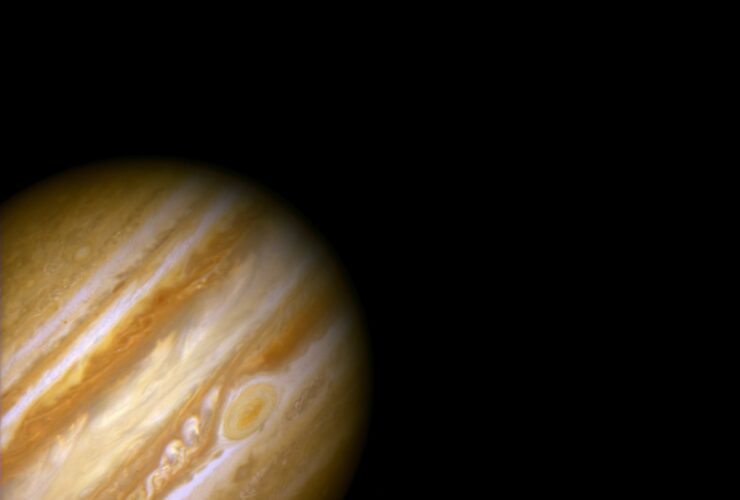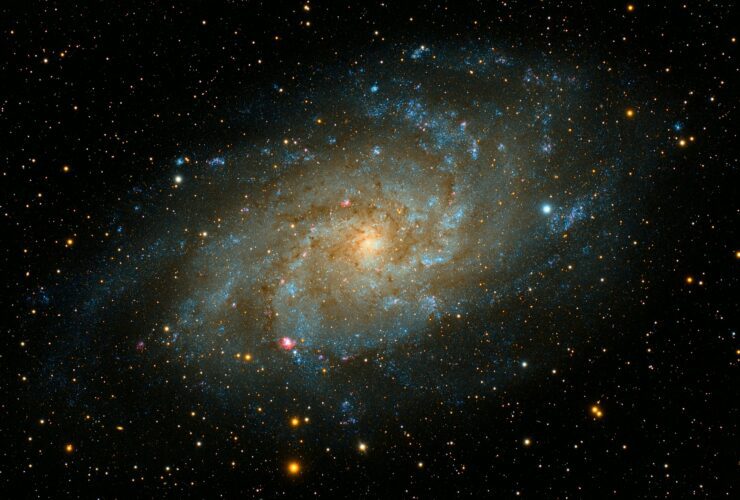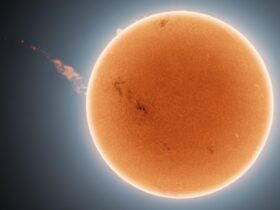An astrophysicist took this shot with a long exposure on June 18, 2018, just before the megacomet made its closest visit to Earth. The image shows the comet glowing in the darkness. Comet C/2017 K2 (PANSTARRS), also known as K2, ...
The Lunar Reconnaissance Orbiter (LRO), which serves as NASA’s “eye in the sky” in orbit around the Moon, has located the impact site of the unidentified rocket booster that crashed into the opposite side of the Moon on March 4, ...
In our solar system, Jupiter was one of the earliest planets to form, but we know very little about the process through which it came to be. Jupiter, according to a new scientific research, is the biggest planet in our ...
An undiscovered black hole lurking in the Milky Way galaxy may be the world’s tiniest ever, according to one calculation of its mass. An isolated stellar-mass black hole was discovered earlier this year by a team headed by Space Telescope ...
Trojan worlds, which are co-orbiting planets, have not yet been discovered outside of our solar system. According to recent research, it’s odd considering that we see them all the time in our own backyards. It is not uncommon to see ...
The cosmos is a diverse and complicated system with many unanswered questions. To yet, the mapping of the universe by astronomers has shown that tiny galaxies may be randomly scattered around their hosts. However, new research shows that these small ...
There’s an enormous asteroid on its way to Earth, and NASA is watching it closely. Asteroid 388945 (2008 TZ3) is expected to approach Earth on May 15th, according to NASA. Up to 1,608 feet in width is expected for the ...
Water was previously thought to have been present on Mars for at least three billion years. NASA’s Mars Reconnaissance Orbiter, for example, detected salt crystals that suggest water may have existed as recently as two billion years ago. The Zhurong ...
Chinese scientists recently reported in the journal Joule that the lunar soil possesses active molecules capable of converting carbon dioxide into oxygen and energy. To help with human explorations of the moon and beyond, they’re now looking into lunar assets. ...
On the Moon, there exist molecules of water and ice, but how did these materials get up there? There’s a good chance that part of the water on the moon came from asteroids and comets colliding, but recent research reveals ...
Experts think that Europa’s subterranean lakes of salty water might be ideal locations to hunt for indications of life outside our planet’s atmosphere. Researchers uncovered evidence for the existence of tiny ponds under the Jovian moon’s frozen surface after seeing ...
An asteroid impact 4.3 billion years ago caused havoc in the moon’s mantle, explaining why one side of the moon has more craters than the other. A recent study supports this theory. Per the International Astronomical Union, the moon has ...
Despite the vast distances involved, astronomers have captured the light of a single star from the beginning of the Universe. It is the most remote object of its kind yet discovered, dating from just 900 million years after the Big ...
The Cassiopeia A supernova’s inner nebula isn’t traveling outward evenly. Astronomers from the University of Amsterdam and Harvard have found this new phenomenon. There is a strong possibility that the remains have been impacted by another object. The Astrophysical Journal ...
Our solar system was formed by violent collisions between rocky bodies. The frequency of comparable accidents near other stars may be inferred from observations of similar crashes. There have been several collisions between planets in our solar system, notably Earth ...
Once again, something really hazardous has occurred! Just hours before it was due to strike Earth near the western coast of Greenland, the same astronomer who spotted Asteroid 2022 EB5 earlier this week has discovered yet another frightening asteroid. Asteroid ...
Astronomers have captured the first-ever high-definition photograph of a strange circle in space as they investigate the origins of these enigmatic objects. Pictures from the Australian Square Kilometer Array Pathfinder radio telescope (ASKAP) in 2019 revealed mysterious formations known as ...
In space, anything may go awry. An object collides with another object, inflicting damage or forming new celestial bodies. Scientists play the role of astronomical detectives, piecing together the events of these crashes and gleaning information regarding the objects concerned ...
The James Webb Space Telescope, operated by NASA, has completed another important mirror alignment phase and has published the highest quality infrared picture yet obtained by a space telescope. The James Webb Orbit Telescope captured its first images in space ...
The planet Venus has become something of a forgotten world, despite the fact that it is nearer to us compared to Mars and, in some respects, more similar to Earth than the red planet. In terms of dimension and density, Venus ...
A space internet project in its early stages has recently secured $650,000 in initial money to work on research and technical evaluations in order to link the Earth, the moon, and possibly Mars with high-speed internet access. In a press ...
Every black hole has a problem at its core. They carry a little piece of the Universe with them as they sizzle away into nothingness throughout the ages. It’s a dilemma that Stephen Hawking highlighted in his groundbreaking work on these giant ...
A dead star on the run that is zipping across space at breakneck speeds has left a massive trail of matter as well as antimatter particles in its wake. The star is a pulsar known as PSR J2030+4415 or J2030 ...
Galaxies seldom exist in isolation. Instead, gravity draws hundreds to thousands of them together, generating huge clusters that are the universe’s biggest objects. Scientists have determined that the hydrogen gas inside galaxy clusters is very hot—roughly 10 million degrees Kelvin, ...
Astronomers have only detected four asteroids before they reached the Earth’s atmosphere: 2008 TC3, 2014 AA, 2018 LA, and 2019 MO. This is because detecting an asteroid before it enters the Earth’s atmosphere is such an uncommon occurrence for astronomers. ...

























